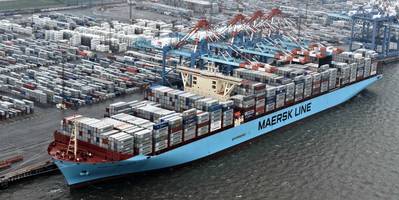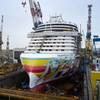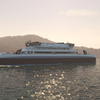The newbuild “arms race” for mega containerships may not deliver the hoped-for cost benefits, according to shipping consultancy Drewry, whose study on these increasingly massive vessels found new operational and financial impacts on lines, terminal operators, ports and other supply chain stakeholders.
The results of Drewry’s simulation study show that the economies of scale – a key feature of the liner industry – may be running out as vessel size increases up to and beyond 18,000 teu.
Aiming to drive down unit costs and improve profitability, ship lines have been spurring a rapid uptick in the size of container vessels ordered since 2009; and with 53 megaships expected to enter service this year, this arms race for newbuilds is set to continue in 2016. But according to Drewry’s latest study, while these larger ships help carriers reduce voyage costs, savings are increasingly offset by higher port and landside costs, meaning that total system cost savings are small and declining.
As many stakeholders have found, the larger megaships place increasing amounts of strain on ports, where channels have to cater for deeper draughts, while terminals need to upgrade equipment, yard facilities and manning levels to effectively handle greater peak cargo volumes. At current levels, terminal yard areas will need to increase by one third to avoid congestion, even with no growth in volume, according to the study.
Drewry found that the upsizing of vessels provides only a modest 5 percent savings for the overall supply chain on a total ‘system cost’ basis, with efficiency gains eroding further as vessels exceed 18,000 teu. Scale economies from megaships therefore only work for the total supply chain if terminals can increase productivity in line with increases in vessel size, Drewry said.
Drewry said it expects that even with no further increase in maximum vessel size, the sheer number of mega vessels expected to be delivered in 2016 will strain terminal resources, as the average size of ships increase the amount of cargo that has to be handled at times of peak container activity.
Continued vessel upsizing also poses greater risks, leading to no significant cost benefit, lower service frequency and/or less choice for shippers; higher supply chain risks as volumes are concentrated in fewer vessels; and environmental effects arising from dredging deeper channels and expanding yard area.
“As more megaships enter service the industry is rapidly approaching a critical stage,” said Tim Power, managing director of Drewry. “To ensure the economics of vessel upsizing continue to benefit the entire supply chain, lines and ports need to work in a more coordinated manner if further productivity improvements from the transport system are to be realized. Addressing the operational and cost effects at port facilities caused by the challenging load and discharge patterns of these larger ships requires a cross-industry effort. All stakeholders in the supply chain must recognize the need for dialogue and collaboration if the maritime transport system as a whole is to benefit. If these benefits cannot be delivered and economies of scale in this industry really are running out, the implications are profound.”
There is a wider possible implication of these findings for the industry, Drewry said: if economies of scale in liner shipping have finally run their course, future vessel ordering will no longer be driven by the need to secure economies of scale but will instead be based on lines’ assessment of future demand growth.
“When this happens, the tendency to structural overcapacity that has plagued the industry will be much reduced,” Power added. “If this were combined with a process of continuing industry consolidation, liner shipping might at last be in a position to generate sustainable profitability.”











